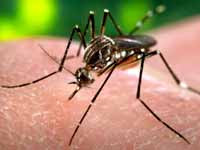
February 2008.
The worst winter weather in 50 years in China's central, southern and eastern regions could be connected to air cyclone change and the La Nina phenomenon, the climatic opposite of El Nino, an Egyptian meteorological official said Monday.
 The heavy snow that snarled central and southern China could be due to climatic change as there are many cyclones hovering near those areas.
The heavy snow that snarled central and southern China could be due to climatic change as there are many cyclones hovering near those areas. La Nina is the opposite of El Nino, which follows El Nino and occurs every few years. During La Nina, sea temperatures over eastern equatorial Pacific are lower than normal. La Nina enhances Arctic weather systems and causes a cold winter in Asia, including in China.As warm and moisture air from the south meets cold air in the north under freezing temperatures, snow forms.
"The warm air is very active this year," said Li Weijing, deputy director-general of the National Climate Center of China.
Since Jan 10, snow, sleet and low temperatures have swept China's southern regions, a rarity for the area. The terrible weather has been more extreme in the central provinces of Hubei and Hunan.
A lingering blizzard, which has lasted more than two weeks, was the longest in the past 100 years. In Hunan, ice coating electricity transmission cables was between 30 and 60 millimeters thick.
 Statistics show that the snow has so far killed at least 60 people and forced the evacuation of nearly 1.76 million people.
Statistics show that the snow has so far killed at least 60 people and forced the evacuation of nearly 1.76 million people. The extreme weather, which started around Jan 10, has been blamed for nearly 60 deaths and has affected the lives of about 78 million people in 14 provinces. The death toll and damages are expected to rise as the China Meteorological Administration (CMA) has issued a red alert on Monday (Jan 28) for severe snowstorms forecast in central and eastern region
From Jan 25 to 31, a total of 5.8 million passengers were stranded throughout the railway network and more than 8,000 cargo trains were affected.
More news...

Winter crops have been destroyed. That has compounded the shortages, especially of food, that are stoking inflation, already high and politically sensitive. Supplies of some foods reaching wholesalers in Beijing are down to a fifth of normal levels. Prices of vegetables in the 11 inland provinces have seen large rises--in some cases, doubling--regardless of a crackdown by the government, which started in January, on price manipulation.
Despite having now put 350,000 troops and more than 1 million reservists and police to relief work, the leadership initially underestimated the severity and longevity of the bad weather and was slow to respond. The government has now activated its "Red Alert" emergency management procedures but is struggling to get the affected areas of country, which are China's most populous, on the move.
 The sheer scale of the crisis is daunting. Millions of people across more than 3,000 square miles are still stuck in temporary shelters or stranded in transport hubs. Fuel, food and medical supplies are dwindling. Power is still out in many cities, and water supplies and communications are intermittent at best. Officials say 150,000 homes have collapsed and another 650,000 have been seriously damaged.
The sheer scale of the crisis is daunting. Millions of people across more than 3,000 square miles are still stuck in temporary shelters or stranded in transport hubs. Fuel, food and medical supplies are dwindling. Power is still out in many cities, and water supplies and communications are intermittent at best. Officials say 150,000 homes have collapsed and another 650,000 have been seriously damaged. Remote areas are still cut off, which means the official death toll of 60 dead is also likely to be an underestimate. Meanwhile, the forecast is for harsh weather to continue for some days.
 World temperatures will cool slightly in 2008
World temperatures will cool slightly in 2008World temperatures will cool slightly in 2008, but it will remain among the top 10 hottest years on record, British weather experts predicted Thursday.
The impact of a strong La Nina climate pattern over the Pacific will help keep temperatures down, according to the annual forecast by the Met Office and the University of East Anglia.
Overall the global temperature is expected to be 0.37 degree Celsius above the long-term average of 14.0 degree, making it the coolest year since 2000 when the value was 0.24 degree C above the average.
"Phenomena such as El Nino and La Nina have a significant influence on global surface temperature and the current strong La Nina will act to limit temperatures in 2008," said Professor Chris Folland of the Met Office.
"However mean temperature is still expected to be significantly warmer than in 2000 ... Sharply renewed warming is likely once La Nina declines," he added.
The forecasts take into account El Nino and La Nina, ballooning greenhouse gas levels as well as solar effecta and natural variations in the world's oceans.
The cooling comes against the background of an underlying warming trend, said Professor Phil Jones, Director of the Climatic Research Unit at the University of East Anglia.
"The fact that 2008 is forecast to be cooler than any of the last seven years -- and that 2007 did not break the record warmth set on 1998 -- does not mean that global warming has gone away," he said.
"What matters is the underlying rate of warming -- the period 2001-2007 with an average of 0.44 degree Celsius above the 1961-90 average was 0.21 degree Celsius warmer than corresponding values for the period 1991-2000."
La Nina, effectively a drop in sea surface temperatures off the western coast of South America, can cause havoc with weather patterns in many parts of the globe.
El Nino, a warming of Pacific sea surface temperatures, was blamed for a lengthy drought in Australia, flooding in the Horn of Africa and Bolivia, and more severe winter monsoons in South Asia in 2006-2007.




